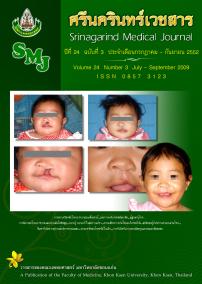ThaiScience
ThaiScience
SRINAGARIND MEDICAL JOURNAL
Volume 35, No. 04, Month JULY, Year 2020, Pages 470 - 475
Responsiveness of lumbar lordosis angle and other biomechanical parameters in individuals with lumbar hyperlordosis an experimental study
Thanachaporn Janyathitipath, Prasert Sakulsriprasert, Peemongkon Wattananon, Phunsuk Kantha
Abstract Download PDF
Background and Objective: The assessment and management in individuals with lumbar hyperlordosis are important to prevent further musculoskeletal disorders. The responsiveness is necessary to be studied because it represents the ability of each parameter to indicate the change overtime, which awaits formal investigation. This study aimed to investigate the responsiveness of biomechanical parameters in individuals with lumbar hyperlordosis. Methods: Fifteen individuals with lumbar hyperlordosis, aged 20 to 30 years, were recruited. The parameters measurement were angle of lumbar lordosis (ALL), degree of hip flexion, degree of hip abduction, degree of knee flexion, and percent maximum voluntary isometric contraction (%MVIC) of transversus abdominis/internal abdominal oblique (TrA/IO), rectus abdominis (RA), external abdominal oblique (EO), lumbar erector spine (LES), and multifidus (MF). They were assessed 2 times: before and after iliopsoas stretching. Results: Change score, effect size, and standardized response mean (SRM) were calculated to represent the responsiveness of each parameter. The findings showed that the most responsive parameter was ALL, SRM of 1.61, while, the other parameters had lower responsiveness. Conclusion: This study supported that ALL was the most responsive parameter to detect the change in individuals with lumbar hyperlordosis after the intervention aiming for decreasing lumbar lordosis
Keywords
EMG effect size change score lumbar spine sensitivitySRINAGARIND MEDICAL JOURNAL
Published by : Faculty of Medicine, Khon Kaen University
Contributions welcome at : http://www.smj.ejnal.com/e-journal/journal/index.php
